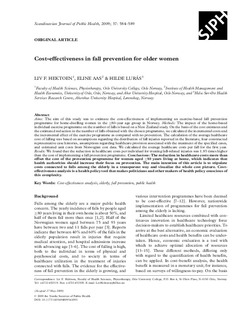| dc.contributor.author | Hektoen, Liv F. | |
| dc.contributor.author | Aas, Eline | |
| dc.contributor.author | Lurås, Hilde | |
| dc.date.accessioned | 2017-06-07T12:39:59Z | |
| dc.date.available | 2017-06-07T12:39:59Z | |
| dc.date.issued | 2009 | |
| dc.identifier.citation | Hektoen, L.F., Aas, E. & Lurås, H. (2009) Cost-effectiveness in fall prevention for older women. Scandinavian Journal of Public Health, 37(6), s. 584-589. | |
| dc.identifier.uri | http://hdl.handle.net/11250/2445101 | |
| dc.description | Artikkelen beskriver en studie hvor hensikten var å estimere kostnadseffekten av fallforebygging for hjemmeboende eldre kvinner i Norge. | |
| dc.description.abstract | The aim of this study was to estimate the cost-effectiveness of implementing an exercise-based fall prevention programme for home-dwelling women in the 80-year age group in Norway. Methods: the impact of the home-based individual exercise programme on the number of falls is based on a New Zealand study. On the basis of the cost estimates and the estimated reduction in the number of falls obtained with the chosen programme, we calculated the incremental costs and the incremental effect of the exercise programme as compared with no prevention. The calculation of the average healthcare cost of falling was based on assumptions regarding the distribution of fall injuries reported in the literature, four constructed representative case histories, assumptions regarding healthcare provision associated with the treatment of the specified cases, and estimated unit costs from Norwegian cost data. We calculated the average healthcare costs per fall for the first year. Results: we found that the reduction in healthcare costs per individual for treating fall-related injuries was 1.85 times higher than the cost of implementing a fall prevention programme. Conclusions: the reduction in healthcare costs more than offset the cost of the prevention programme for women aged 80 years living at home, which indicates that health authorities should increase their focus on prevention. The main intention of this article is to stipulate costs connected to falls among the elderly in a transparent way and visualize the whole cost picture. Cost-effectiveness analysis is a health policy tool that makes politicians and other makers of health policy conscious of this complexity. | |
| dc.language.iso | eng | |
| dc.title | Cost-effectiveness in fall prevention for older women | |
| dc.type | Journal article | |
| dc.rights.holder | Hektoen, Liv | |
| dc.source.volume | 37 | |
| dc.source.journal | Scandinavian Journal of Public Health | |
| dc.source.issue | 6 | |
| dc.identifier.doi | 10.1177/1403494809341093 | |
| dc.description.localcode | måsjekkes | |
